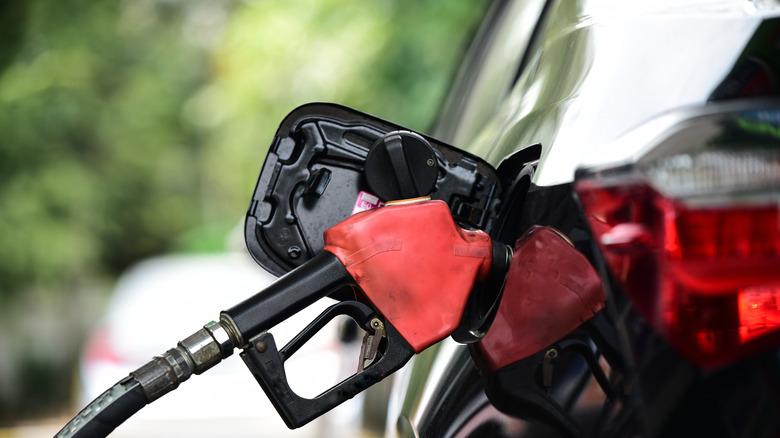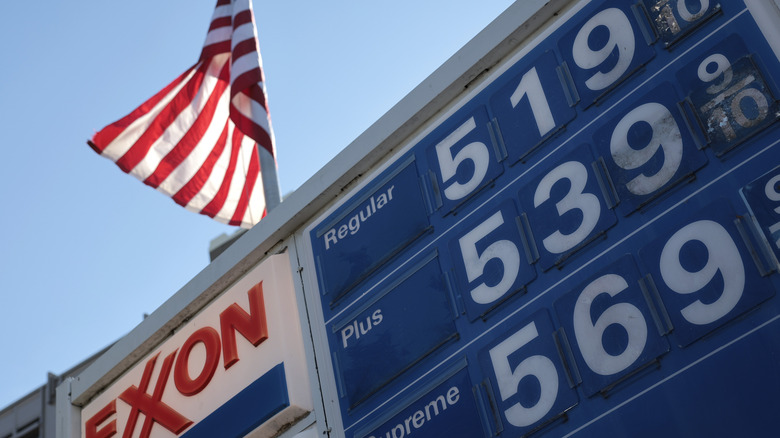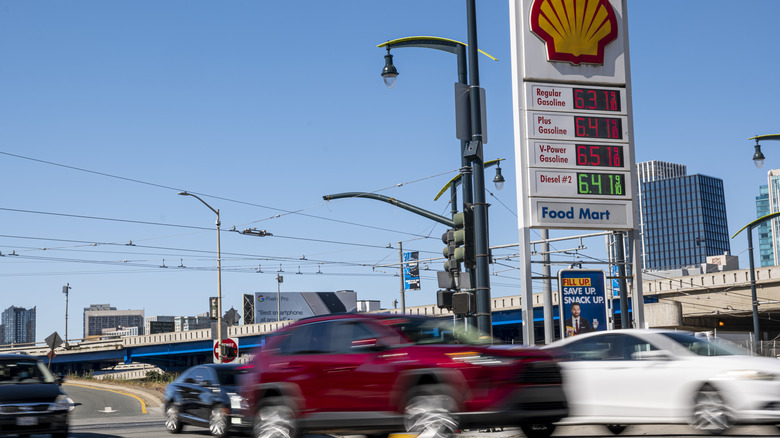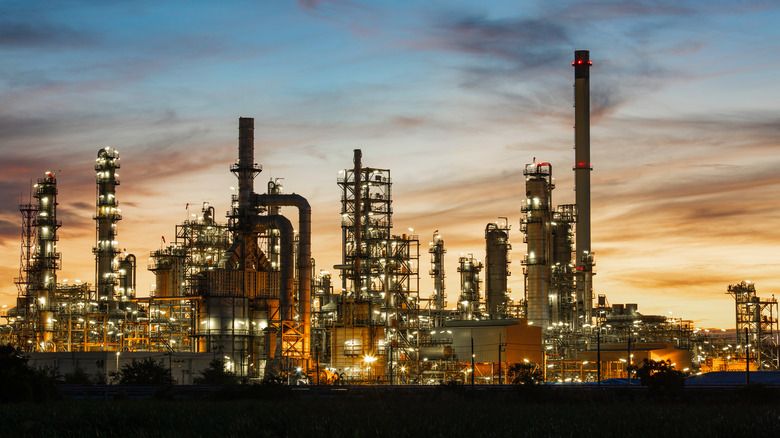Which State Pays The Most For Gas?
As of March 14, 2022, the average price for gas in the U.S. was $4.325 (via AAA). According to Reuters, this is the highest it's been since July 2008. In comparison, gas was 45% cheaper only a year ago. Why the sudden drastic rise? AP News reports that the recent Russian invasion of Ukraine is partly to blame. In 2020, gas prices fell steeply when the world came to a sudden halt due to the pandemic. However, the end of lockdown meant that there was a sudden increase in the need for gas. Americans were ready to hit the road and oil production had yet to catch up.
Insider points out that consumers were feeling the pain at the pump all the way back in November of 2021. This inevitably caused gas prices to escalate in light of the radical change in supply and demand (per CBS News). Of course, the conflict in Ukraine has only worsened the situation. In early March, President Biden announced a ban on Russian oil.
Although the U.S. imports only a minuscule 10% of our supply from Russia, this still has ramifications. As Patrick De Haan from GasBuddy explains, "We don't import a lot, but somebody else does and we are making it difficult for Russian oil to flow to the global market, and prices are reacting to that." War or not, there are other reasons why gas prices can change without warning.
This is why the price of gas changes
According to The Balance, the price of gas is determined by various factors. Besides supply and demand, one must also take into account commodity traders and the value of the U.S. dollar. Traders buy gas contracts for one price and then sell them for another. This can ultimately affect the future cost of gas, especially when the traders sell them for a much higher price. Moreover, there's also the high cost of crude oil. Bankrate writes that high gas prices can affect consumers in more ways than one; it could mean less money for housing, food, and other necessities. Per CNBC, this will only worsen as inflation continues to rise.
Gas is not the only thing that has gone up. Food, rent, and other goods have dramatically increased in price since 2021. The U.S. Energy Administration reports that gas prices fluctuate depending on the season. They are always higher during spring and summer when people drive the most. However, gas prices tend to be lower during the winter. That being said, fires and refinery disasters can also lead to an increase in price. Simply put, gas prices are volatile and are not controlled by one organization or one element.
California's high gas prices
Pew Research writes that historically, the state of California has always had the priciest gas in the U.S. On March 14, 2022, the average cost across the state was around $5.75 a gallon (via AAA). SFGATE explains that this is nothing new for the Golden State as high gas taxes and environmental fees are to blame. Per the California Energy Commission, it costs an average 10 to 15 cents more to make California's gas cleaner, all in an effort to reduce the effects of climate change. Another culprit is California's geographical location. The state is far from major refineries and hardly has any pipelines that connect to other refineries across the country.
According to KTLA, the Rocky Mountains effectively seclude the state from the rest of the U.S. Under normal circumstances, California can meet its population's gas demands. However, if disaster strikes and a refinery has to close down, the state is forced to import gas, leading to even higher gas prices. In addition, there are extra fees added to California's gas, like a carbon offset fee. LAist reports that lawmakers are suggesting a decrease in taxes and other efforts to reduce the overall cost of gas in California.
Why do gas prices differ from state to state?
As Pew Research explains, location is everything. Ultimately, the price of gas is different in every state due to a number of factors. USA Today reports that these include state taxes and the location of refineries and pipelines. Gas, for example, is significantly cheaper around the Gulf Coast compared to the rest of the country. This is because a number of refineries are concentrated in that area. Although the cost of crude oil is generally the same, the process from pipeline to pump is what increases the price.
If a gas station is near a refinery, chances are the price of gas will be lower. If it's not, there's added transportation fees and thus, higher gas prices. Per the U.S. Energy Administration, retail competition and other costs contribute to the varying prices of gas across the country. Of course, there are also gasoline taxes, which are different from state to state (the highest are in California and the lowest in Alaska). Newsweek writes that the same components contribute to different prices at different gas stations in the same state.
Lower gas prices doesn't necessarily mean it's cheaper
According to GasBuddy, the top three states with the lowest average gas price include Oklahoma, Kansas, and Missouri. As of March 14, 2022, the cost in those specific states was under $4 a gallon. CNN points out that just because the gas is cheaper, doesn't mean it's hurting consumers' pockets any less. As they explain, someone in California is more likely to afford the higher gas prices because Californians make 18% more than the national average. However, someone in Mississippi, where the price of gas is relatively low, has to work more to pay for gas because their wages are lower.
Nonetheless, everyone is undoubtedly feeling the financial strain of high gas prices. Bankrate writes that several things can be done in an effort to save at the pump. These include driving at lower speeds, keeping heavy items out of cars, and combining trips to overall use a vehicle less than needed. Despite the deep increase in gas prices, CBS reports that a recent poll showed that a majority of Americans is willing to pay more for gas if it means being able to punish Russia for their invasion of Ukraine.
Why gas prices could remain high
CBS News reports that this recent increase in gas prices could lead to an additional $2,000 cost to the average household. Sadly, it's believed that things might get worse before they get better. Patrick De Haan from GasBuddy says, "It's difficult to know — it could be weeks or months," for gas prices to drop. PBS writes that besides the conflict in Russia, the demand for gas has continued to increase while the oil industry is still feeling the effects of the COVID-19 lockdown. According to Good Housekeeping, it's predicted that average gas prices will stay over $4 until the end of November.
The number could be higher depending on the situation in Ukraine. In other words, the situation is truly unpredictable. Despite this, consumers are already making changes in their lifestyles. Per CBS News, several Americans have decided to budget more and drive less. This can also affect people who don't drive.
Uber, a rideshare app, has recently implemented additional fees in the U.S. and Canada due to the increase in gas (via NBC News). This surcharge will go to the driver as they are the ones who pay for their fuel. The Balance explains that this surge in gas prices will be felt throughout the economy. Ultimately, it determines how much a consumer will spend on other commodities and items.





